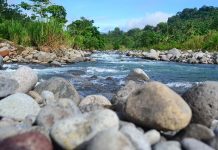In-house teams of the Department of Education in Region XI will conduct rapid assessment of school buildings to ensure the safety of children after a 4.6 magnitude earthquake hit Davao City on Thursday morning, an official said.
“Every month, a DepEd team monitors school buildings and receives requests for rehabilitation and repair,” Dr. Warlito E. Hua, DepEd XI Chief of Education Support and Services said when asked what DepEd will do to ensure that schools are safe.
Schools also submit construction updates to him and some are instructed to condemn old buildings that are no longer safe for use, he said.
Out of fear, some parents rushed to fetch their children after the quake struck.
Hua said that the waiting shed outside the Palma Gil Elementary School in Quirino Street which collapsed and injured two women was built by the city government.
Central 911’s emergency medical service immediately attended to the two women and three students of V. Corcuera Elementary School in Barangay Panacan who fainted.
Hua said DepEd engineers validated the structure and will coordinate with the city as part of their standard operating procedure after an earthquake. He cited initial reports that the structure was no longer safe.
He said the assessment of school buildings is in line with the recent directive of DepEd Secretary Leonor Briones to make these structures disaster-resilient.
DepEd XI engineer Nigel Borja said that his team had not received any report of old school structures being affected by the earthquake.
DepEd will coordinate with DPWH in monitoring school structures including those that are still being constructed.
Classes in the city resumed in the afternoon.
No landslides
The landslide monitoring reports of the City Disaster Risk Reduction and Management Office’s Operations and Warning Section said no untoward incidents happened in areas that have moderate to high landslide susceptibility.
The areas under close monitoring by DRRMO include Matina Crossing Area (Purok Guadalupe, Quiniones Compound, Pluto Street in GSIS, and Shrine Hills by the Diversion Road);
Barangay Mandug’s DFF Village); Barangay Buhangin’s Purok Damayan); Barangay Maa (Shrine Hills Naselia Village and Inigues Village); Barangay 19’s Awhag Subdivision by the Davao River Bank; and Matina Pangi.
Barangay DRRMCs were directed to standby in landslide prone areas to inspect and monitor the situation.
Need for awareness
CDRRMO chief Emmanuel Jaldon said there is a need for stronger disaster education in schools.
He said many students have low awareness on DRRM because it is not yet institutionalized.
DRRM education is not a school subject itself but only a component of subjects like science and social science, he noted.
He said that while students have basic knowledge on what to do during earthquakes and other disasters, these skills do not stick to them for a long time.
He added there is a need to inculcate DRRM through frequent practice, like in Japan where students are made to do drills daily before classes start.
“Practice needs to be frequent until students reach a level of unconscious compliance,” Jaldon said, referring to application of DRRM skills by reflex.
There is also a need to involve students in hazard-mapping within school environments. These can range from identifying potential risks or hazards in campuses. These include unsound structures, electrical wiring, and flammable materials.
Students, Jaldon said, should also have good understanding of access to exit points in schools. He said these can vary depending on school location—some are situated next to highways, while others are near bodies of water.
“Once you identify these risks, you can put in measures to prevent disasters from happening,” he said. (Jesse Pizarro Boga/MindaNews)






